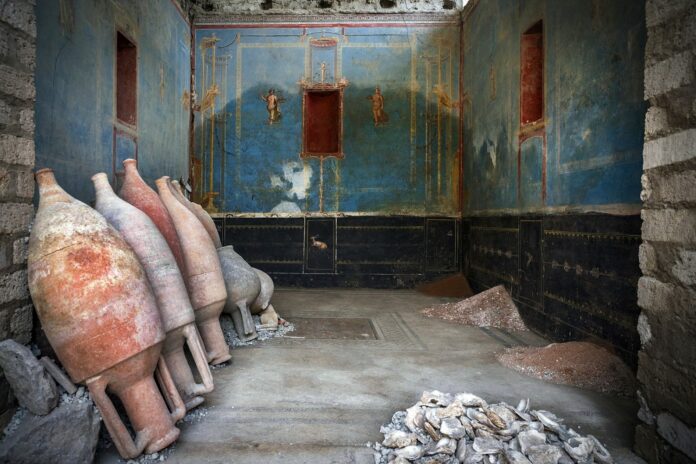Stunning Roman Shrine With Rare Blue Paint Uncovered in Pompeii Find
In a remarkable discovery, archaeologists have unearthed a stunning Roman shrine adorned with rare blue paint in the ancient city of Pompeii. This find, located in the Regio IX area, offers a unique glimpse into the artistic and religious practices of the Roman Empire before the catastrophic eruption of Mount Vesuvius in 79 AD.
The shrine, known as a lararium, is dedicated to the household gods, or Lares, and would have been a central feature in the daily lives of Pompeii’s inhabitants. What makes this discovery particularly extraordinary is the use of blue pigment, which was both rare and expensive in the ancient world. The vibrant blue color, derived from the mineral azurite, has been preserved remarkably well, offering a vivid display of ancient Roman craftsmanship.
Dr. Maria Paola Guidobaldi, the lead archaeologist on the excavation, expressed her excitement: “This shrine is an exceptional find, not only because of the rare blue paint but also due to its excellent state of preservation. It provides invaluable insight into the domestic religious practices and the aesthetic preferences of the people of Pompeii.”
The lararium features intricate frescoes depicting mythological scenes, including the gods Mercury and Bacchus, surrounded by vibrant floral motifs and fantastical creatures. The blue paint used in these frescoes was a luxury item, often reserved for the most important and opulent spaces, indicating the wealth and status of the household that commissioned it.
In addition to the frescoes, the shrine contains a small altar and various artifacts such as pottery, lamps, and figurines, which were likely used in daily rituals. These objects, along with the stunning artwork, help paint a comprehensive picture of the spiritual life in ancient Pompeii.
The discovery of the blue-painted lararium not only enriches our understanding of Roman religious practices but also highlights the sophisticated techniques and materials used by ancient artists. The preservation of the colors and details offers a rare opportunity for researchers to study Roman art in its original context.
This find is part of the ongoing efforts to explore and preserve the vast archaeological heritage of Pompeii. The site continues to reveal new secrets, providing a window into the daily lives of its ancient inhabitants and the catastrophic events that led to its preservation under layers of volcanic ash.


